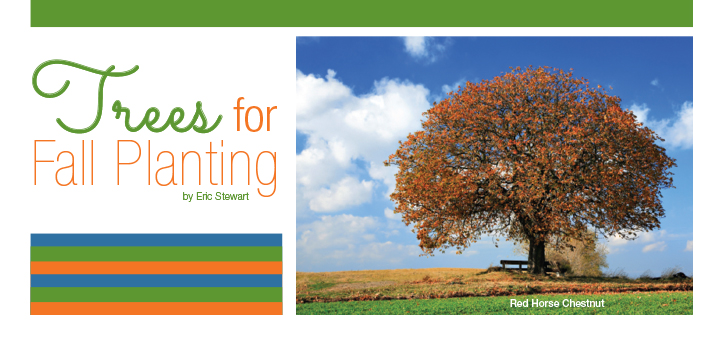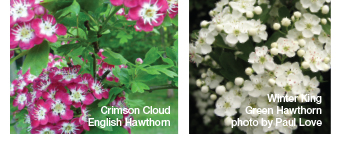
Fall is a wonderful time for planting trees. The dog days of summer have passed. There is a wonderful crispness in the air, and the cold winds have yet to blow. So, why not spend some time outdoors communing with nature and preparing for an even more beautiful garden next season?
Planting trees is an investment in your property. They add privacy and beauty, screen unwanted views, provide shade on hot summer days, and provide food and shelter for wildlife. Fall planting is also a great outdoor activity for the whole family. In addition, most nurseries and garden centers offer great sales at this time of year so autumn planting also makes good financial sense. The only downside to purchasing plants this time of year is that selection may not be as great as earlier in the season, but in light of the other benefits, this is hardly a deal breaker.
Now the question arises:
what to plant?
The following are a few suggestions based upon
years of experience both in my own garden
and those of my clients.
Trees
In general, when selecting a tree, one should purchase a specimen that is large/tall enough to withstand possible browsing by Bambi and not be utterly destroyed. Even species that are generally considered deer-resistant are sometimes subject to such nibbling. Usually this happens either in winter, when food is most scarce, or in spring, just as succulent new growth emerges. Whether out of hunger, boredom with their usual diets, or sheer spite, deer don't always get the memo that they are not supposed to eat certain plants. Thus, I recommend that homeowners only install trees that are a minimum of 7-8' tall when planted in the ground. Otherwise, even minor browsing can prove fatal to your sapling. Besides, who wants to wait years and years for the payoff after planting a twig?
One of my favorite trees is the Red Horse Chestnut (Aesculus carnea 'Briotii'). This lovely mid-sized tree matures to around 30' tall and wide. It is a great general landscaping tree that is widely planted in the UK and Western Europe, though is it is far rarer on this side of the Atlantic. However, I have one in my own yard and have planted it for several clients. It needs full sun and moist, deep, well-drained soil. In May, it is covered in large, 8-10" tall upright clusters of rose-colored flowers that are truly spectacular. The only downside to this tree is that the fall foliage is not particularly attractive, and its large leaves may brown out during extended periods of summer drought, if the tree does not receive sufficient moisture. Aside from these issues, Red Horse Chestnut makes a wonderful and dramatic addition to any landscape.

Serviceberry (Amelanchier species), aka Shadblow & Juneberry — This family of flowering trees or large shrubs is native to the Eastern US from Canada to Georgia. They are adaptable and very easy to grow in most any soil, provided they have full to part sun. In the wild, they are often found growing on sunny, wooded slopes, beside ponds, and at the forest's edge, and they are perfectly suited to similar situations in a yard or garden. In general, serviceberries offer many benefits to the landscape. In spring, they produce a wonderful (though somewhat short-lived) display of delicate, white flowers. This is followed later in the season by edible fruits that resemble small blueberries, which birds find irresistible. Hence, it is a great plant for attracting beneficial pollinating insects and a variety of feathered friends to the garden. As implied by its name, Amelanchier grandiflora, or Autumn Brilliance, is a wonderful tree form of the species that matures to 25' or so in height and features very attractive fall foliage in colors ranging from bright yellow to deep red.
Heritage River Birch (Betula nigra 'Heritage') — If you are looking for a large, fast-growing native tree that is almost foolproof, try planting a Heritage River Birch. Usually sold as a clump of three to five trunks, this tree is very easy to grow in average to moist soil and in full to part sun. It can even thrive in soggy areas, since in nature it is found growing on riverbanks. Eventually maturing to a statuesque height of up to 60', this species features attractive, tan-colored exfoliating bark that gets lighter with age. As with other birches, the autumn foliage color is yellow. However, unlike its familiar woodland cousin, the Paper Birch, River Birches are long-lived and unaffected by most pests and diseases.
Japanese Stewartia (Stewartia pseudo camellia) or Chinese Stewartia (Stewartia sinensis) — If you stumble upon either specimen, buy it. They are beautiful trees. The two species are very similar in appearance, with the main difference being their size at maturity. The Chinese variety is smaller, reaching only 20-25' or so in height, while the Japanese variety will eventually reach up to 40' tall and 20' wide. Both grow relatively slowly and require moist, well-drained, acidic soils in full sun. As implied by the name Pseudo camellia, Stewartias boast lovely white flowers with golden centers that closely resemble the blooms of a camellia or a rose. These fragrant, 3"-wide flowers appear in July. Stewartias also feature very attractive exfoliating bark in mottled shades of gray, brown, and tan that provides year-round interest. As an added bonus, the Chinese Stewartia that I have in my own garden has proven itself very resistant to browsing by deer. In fact, they've never touched any of the lower limbs—an uncommon occurrence in my yard, I can assure you.

Hawthorn (Crataegus species) — There are many species of hawthorn available at nurseries. Some are somewhat shrubby, leggy and multi-stemmed in appearance, while others are treelike in form. However, all hawthorns are noted for their late spring blooms, fall berries, and, of course, their rather imposing thorns. As such, if you a looking for a tree for the little ones to climb, these are not the trees for you. However, if you seek a hardy, adaptable tree that offers year-round interest and attracts birds to the garden, please read on. My favorite variety of Hawthorn is Winter King Green Hawthorn. (Crataegus viridis 'Winter King'). It has a lovely, rounded habit and matures to a manageable size of 20-30' tall and wide. It boasts lustrous, dark green foliage and masses of small white flowers in May. In fall, this tree puts on an impressive show of red berries that persists well into the winter, thus bringing birds to the garden. It also features attractive gray bark and a nice branching pattern that adds architectural winter interest. Crimson Cloud English Hawthorn (Crataegus laevigata 'Crimson Cloud') is another lovely flowering tree ideally suited to our region. It is slightly smaller than its cousin, the green hawthorn, and features many of the same attributes. However, the cultivar Crimson Cloud boasts stunning, dark rose-red flowers with white centers. It is very showy while in bloom. I have several specimens of both Winter King and Crimson Cloud in my yard. Of the two, Winter King seems more vigorous, but I absolutely love them both.

Lastly, a few words of warning regarding fall planting: Avoid purchasing deciduous trees after the leaves have fallen, because it then becomes difficult to judge the health of the tree you might be considering. Also, plan to finish your fall planting by mid-November, since trees ideally need four to six weeks to acclimate to their new homes prior to the ground freezing. In the Mid-Hudson Valley, this usually happens around the end of December. With spring-flowering bulbs, you have a bit more leeway. I have even been known to plant daffodils, tulips, and alliums during snow flurries as long as the soil is still workable, but trees need more time to adapt.
Now go out and plant something!
Here are a few nurseries or garden centers to help you get started: Adams, Apple Bin, Augustine Landscaping, Barthel's, Buzzanco's, Gallo's, Gills, Greenman Garden Design, Saunderskill, Veronica Gardens, Wallkill View, Wright's
Eric Stewart is a garden designer, writer, and artist who lives in Accord, NY. He may be reached at Greenman Garden Design; greenmangarden.com; 845-687-0407; or via email at elsgreenman@aol.com. Aside from planting and designing, he is also finishing work on his first novel.

